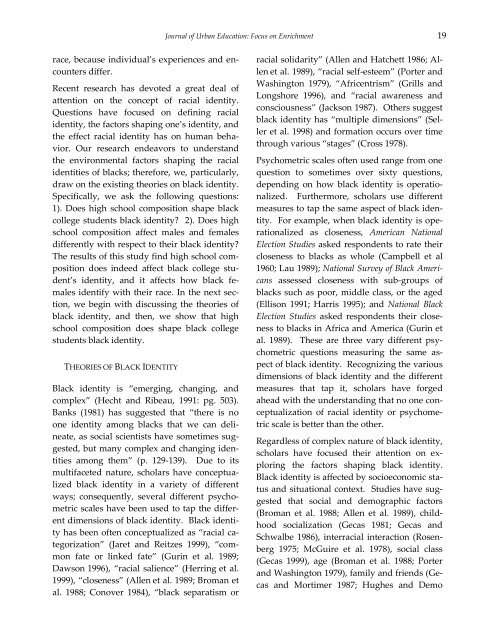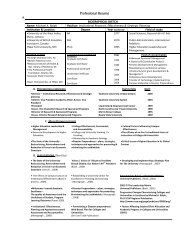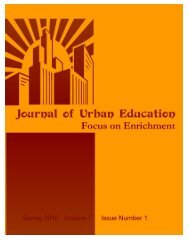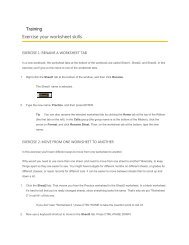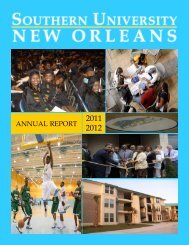Journal of - Southern University New Orleans
Journal of - Southern University New Orleans
Journal of - Southern University New Orleans
- No tags were found...
Create successful ePaper yourself
Turn your PDF publications into a flip-book with our unique Google optimized e-Paper software.
<strong>Journal</strong> <strong>of</strong> Urban Education: Focus on Enrichment 19race, because individual’s experiences and encountersdiffer.Recent research has devoted a great deal <strong>of</strong>attention on the concept <strong>of</strong> racial identity.Questions have focused on defining racialidentity, the factors shaping one’s identity, andthe effect racial identity has on human behavior.Our research endeavors to understandthe environmental factors shaping the racialidentities <strong>of</strong> blacks; therefore, we, particularly,draw on the existing theories on black identity.Specifically, we ask the following questions:1). Does high school composition shape blackcollege students black identity? 2). Does highschool composition affect males and femalesdifferently with respect to their black identity?The results <strong>of</strong> this study find high school compositiondoes indeed affect black college student’sidentity, and it affects how black femalesidentify with their race. In the next section,we begin with discussing the theories <strong>of</strong>black identity, and then, we show that highschool composition does shape black collegestudents black identity.THEORIES OF BLACK IDENTITYBlack identity is ‚emerging, changing, andcomplex‛ (Hecht and Ribeau, 1991: pg. 503).Banks (1981) has suggested that ‚there is noone identity among blacks that we can delineate,as social scientists have sometimes suggested,but many complex and changing identitiesamong them‛ (p. 129-139). Due to itsmultifaceted nature, scholars have conceptualizedblack identity in a variety <strong>of</strong> differentways; consequently, several different psychometricscales have been used to tap the differentdimensions <strong>of</strong> black identity. Black identityhas been <strong>of</strong>ten conceptualized as ‚racial categorization‛(Jaret and Reitzes 1999), ‚commonfate or linked fate‛ (Gurin et al. 1989;Dawson 1996), ‚racial salience‛ (Herring et al.1999), ‚closeness‛ (Allen et al. 1989; Broman etal. 1988; Conover 1984), ‚black separatism orracial solidarity‛ (Allen and Hatchett 1986; Allenet al. 1989), ‚racial self-esteem‛ (Porter andWashington 1979), ‚Africentrism‛ (Grills andLongshore 1996), and ‚racial awareness andconsciousness‛ (Jackson 1987). Others suggestblack identity has ‚multiple dimensions‛ (Selleret al. 1998) and formation occurs over timethrough various ‚stages‛ (Cross 1978).Psychometric scales <strong>of</strong>ten used range from onequestion to sometimes over sixty questions,depending on how black identity is operationalized.Furthermore, scholars use differentmeasures to tap the same aspect <strong>of</strong> black identity.For example, when black identity is operationalizedas closeness, American NationalElection Studies asked respondents to rate theircloseness to blacks as whole (Campbell et al1960; Lau 1989); National Survey <strong>of</strong> Black Americansassessed closeness with sub-groups <strong>of</strong>blacks such as poor, middle class, or the aged(Ellison 1991; Harris 1995); and National BlackElection Studies asked respondents their closenessto blacks in Africa and America (Gurin etal. 1989). These are three vary different psychometricquestions measuring the same aspect<strong>of</strong> black identity. Recognizing the variousdimensions <strong>of</strong> black identity and the differentmeasures that tap it, scholars have forgedahead with the understanding that no one conceptualization<strong>of</strong> racial identity or psychometricscale is better than the other.Regardless <strong>of</strong> complex nature <strong>of</strong> black identity,scholars have focused their attention on exploringthe factors shaping black identity.Black identity is affected by socioeconomic statusand situational context. Studies have suggestedthat social and demographic factors(Broman et al. 1988; Allen et al. 1989), childhoodsocialization (Gecas 1981; Gecas andSchwalbe 1986), interracial interaction (Rosenberg1975; McGuire et al. 1978), social class(Gecas 1999), age (Broman et al. 1988; Porterand Washington 1979), family and friends (Gecasand Mortimer 1987; Hughes and Demo


